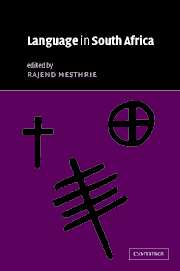Book contents
- Frontmatter
- Contents
- List of maps
- List of contributors
- Acknowledgements
- List of phonetic symbols
- List of abbreviations
- Introduction
- Part I The main language groupings
- Part II Language contact
- 9 Fanakalo: a pidgin in South Africa
- 10 Mutual lexical borrowings among some languages of southern Africa: Xhosa, Afrikaans and English
- 11 Code-switching, mixing and convergence in Cape Town
- 12 Code-switching in South African townships
- 13 Intercultural miscommunication in South Africa
- 14 Women's language of respect: isihlonipho sabafazi
- 15 The sociohistory of clicks in Southern Bantu
- 16 The political economy of language shift: language and gendered ethnicity in a Thonga community
- 17 From second language to first language: Indian South African English
- 18 Black South African English
- 19 The lexicon and sociolinguistic codes of the working-class Afrikaans-speaking Cape Peninsula coloured community
- 20 An Introduction to Flaaitaal (or Tsotsitaal)
- 21 Language and language practices in Soweto
- Part III Language planning, policy and education
- Index
- References
21 - Language and language practices in Soweto
from Part II - Language contact
Published online by Cambridge University Press: 22 September 2009
- Frontmatter
- Contents
- List of maps
- List of contributors
- Acknowledgements
- List of phonetic symbols
- List of abbreviations
- Introduction
- Part I The main language groupings
- Part II Language contact
- 9 Fanakalo: a pidgin in South Africa
- 10 Mutual lexical borrowings among some languages of southern Africa: Xhosa, Afrikaans and English
- 11 Code-switching, mixing and convergence in Cape Town
- 12 Code-switching in South African townships
- 13 Intercultural miscommunication in South Africa
- 14 Women's language of respect: isihlonipho sabafazi
- 15 The sociohistory of clicks in Southern Bantu
- 16 The political economy of language shift: language and gendered ethnicity in a Thonga community
- 17 From second language to first language: Indian South African English
- 18 Black South African English
- 19 The lexicon and sociolinguistic codes of the working-class Afrikaans-speaking Cape Peninsula coloured community
- 20 An Introduction to Flaaitaal (or Tsotsitaal)
- 21 Language and language practices in Soweto
- Part III Language planning, policy and education
- Index
- References
Summary
INTRODUCTION
Language practice, by nature a complex phenomenon, is yet more complex in Soweto where together with English and Afrikaans many African languages are spoken in almost every resident's immediate experience. Apart from the standard African languages used in Soweto, there is also another form of language that seems to cut across all linguistic, political and ethnic barriers created by the apartheid state but which also reflects other barriers. This language is commonly called by its speakers Iscamtho [is/amtho]. This name is probably derived from the Zulu word ukuqamunda [uk'u!amunda], which means to talk volubly. Iscamtho has been confused with Flaaitaal or Tsotsitaal, with which it has many parallels.
The purpose of this chapter is to show that Iscamtho is a different variety from Flaaitaal. Iscamtho has very strong leanings towards Zulu and Sotho: both of these influence the lexical base of Iscamtho even though there are social and linguistic differences between them. Iscamtho also forms a very important marker of urban identity, particularly a Soweto identity which reflects a number of social phenomena. Languages are not abstract entities but important social and historical phenomena which bind, and sometimes reflect cleavages within, communities. Thus, Iscamtho reflects an urban identity and, at the same time, the social barriers between its users and non-users.
Iscamtho is a language that is used ‘through’ another language – a type of basilect, yet it retains its own defining features, i.e. it has no structure of its own since it relies heavily on the language structures of the languages from which it ‘operates’.
- Type
- Chapter
- Information
- Language in South Africa , pp. 407 - 416Publisher: Cambridge University PressPrint publication year: 2002
References
- 14
- Cited by



